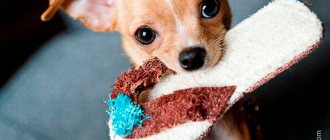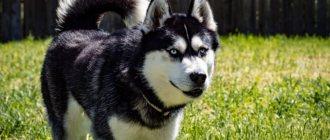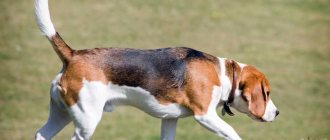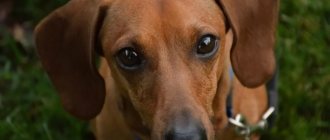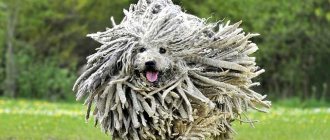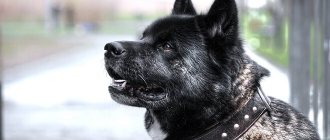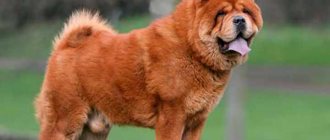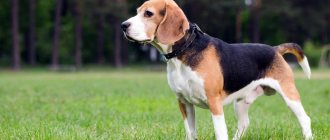Hunting dogs are a special caste of domestic animals, distinguished by their inherent habits, habits and temperament. You can’t expect them to perform security skills, and they won’t sacrifice themselves to save the life of their owner. Therefore, such dogs are not chosen as a protector.
However, in hunting they occupy a leading role - hunting dogs are able to sit in ambush around the clock and non-stop pursue game. Thanks to their impeccable sense of smell, they are able to smell prey several kilometers away, which almost always ensures that the hunter catches a trophy.
Types of hunting dogs - what are they?
Depending on the type of temperament, character traits, characteristics, capabilities and skills, varieties of hunting dogs are distinguished. Each type is used to hunt specific animals.
This is interesting! All breeds of hunting dogs are usually divided into 6 groups.
Hounds
The dignity of hounds lies in perseverance and obedience. Any type of hunting is possible with hounds, since they are well trained and clearly follow commands.
During the hunt, hounds are focused on the target and nothing can distract their attention. Their targets are bears, foxes, wolves, roe deer, deer, moose and wild boars.
- Russian hound
- Russian piebald hound
- Estonian hound
- Basset Hound
- Bloodhound
- American Foxhound
- English Foxhound
- Brazilian hound
- Porcelain hound
Burrows
This type of dog was specially bred for the purpose of catching small game that seeks shelter in the norm. They find living creatures by smell and, if the situation requires it, they pursue and fight with them.
Their main targets are badgers and foxes. Animals have ways of non-stop pursuing their prey, because they do not like to give in.
- Dachshund
- Jagdterrier
- Welterrier, or Welsh Terrier
- Fox terrier
This is interesting! The red fox is one of the most coveted prey for a burrowing dog.
Armory
Gun dogs participate in gun hunting. Animals are capable of sitting in ambush for a long time and chasing prey, covering tens of kilometers.
Used for hunting birds and small animals. The principle of operation is simple - the dog scares away the prey, and then, after the hunter shoots, finds and brings it to the owner.
Cops
A hunting dog, a cop, chooses feathered game as prey. Their task is to catch or scare birds so that, when they fly into the air, they fall into the sights of a hunting rifle. They then go out to find the bird and deliver it to its owner.
- English pointer
- English Setter
- Burton epañol
- Small Munsterlander
Retrievers
According to the FCI standard, dog breeding has established that the retriever is a gun dog. Its main task is to find game birds and put them under the gun. Like pointers, retrievers, after a successful shot from a hunter, must deliver the trophy.
- Golden retriever
- Curly coated retriever
- Labrador Retriever
- Nova Scotia Retriever
- Flat-Coated Retriever
- Chesapeake Bay Retriever
Spaniels
Like the previous two types of gun dogs, spaniels are used to catch feathered animals. The main targets of spaniels are: swamp (snipe, snipe), field (partridge, quail, corncrake), pine (grouse, black grouse, woodcock) and waterfowl (duck) birds.
The operating principle is the same. The dogs search for birds, pick them up and then deliver them to the hunter.
- English cocker
- English springer
- American Spaniel
- American Water Spaniel
- Dutch Spaniel (Koikerhondje)
- Irish Water Spaniel
- Clumber
- German Wachtelhund
- Russian hunting spaniel
- Welsh (Welsh) Springer Spaniel
Likes
Laika is a native hunting breed of dog, originally from the cold North. They show particular assertiveness in their work and do not give up on their goals. Suitable for catching any, even large, game.
- Russian-European Laika
- East Siberian Laika
- West Siberian Laika
- Karelo-Finnish Laika (or Finnish Spitz)
- Nenets Laika (reindeer spitz)
- Yakut Laika
Greyhounds
The greyhound's mission when hunting is to drive down, exhaust the prey, and then make a graceful leap and then deliver the defeated animal to the hunter. It is worth noting that even in the most fierce battle, they do not tear the trophy, so as not to spoil the appearance of its skin.
Hunting with dogs is carried out for hares, rabbits, foxes, wolves and roe deer. Often their target is young deer.
- Russian greyhound
- Azawakh
- Whippet
- Saluki
How to choose the right puppy
To select a future reliable puppy you need:
- know the characteristics of behavior;
- consider different options depending on your hunting goals;
- choose a nursery;
- exclude genetic defects by veterinary examination.
The puppy must be active, cheerful and brave. Excessive cowardice or aggressiveness is excluded.
The competent choice of a dog for the hunter’s goals is a real science that is not difficult to comprehend. It is important to follow simple rules and count on the breeder’s integrity. A defective dog is a huge set of problems.
Training should be carried out by an experienced dog breeder who is able to maintain character, show perseverance, and attention to the future assistant.
Smooth-haired hunting dogs
Smooth-haired dogs have a number of advantages:
- during seasonal molting, the coat change is less noticeable;
- no special care is required for the fur;
- the owner will not have to deal with the problem of combing out tangles.
Typical representatives:
- Smooth-haired dachshund;
- Pharaonova;
- Rabbit Dachshund;
- Estonian hound.
Advantages and disadvantages
Every breed has its positive and negative aspects.
Hunting breeds differ:
- special character, emphasizing activity, obedience, dependence on the owner;
- wool does not require special ongoing care;
- are able to understand a person’s words;
- They are friendly towards their relatives.
Negative aspects are associated with the instinctive desire to run a lot, sniff, and search. They need constant physical activity. Suitable only for those owners who are willing to tolerate the antics of the “hunter”. Keeping them in an apartment becomes problematic for many due to the ringing, trumpet-like or deafening bark that turns into a howl.
Long-haired hunting dog
Caring for a long-haired four-legged friend is always challenging. The period of seasonal molting is considered especially difficult.
Typical representatives:
- Longhaired Golden Retriever;
- Irish Hunting Dog;
- Royal Afghan Hound;
- Irish Water Spaniel;
- Kerry Blue Terrier.
Important! A dog's curly coat is considered the most difficult to care for.
Terriers
Burrowing, short-haired hunters of small rodents. Terriers are very attentive and can track prey by smell.
Jack Russell Terrier
This is a small hunting dog that is in no way inferior to its larger brothers. She has a suspicious and wary look. The Jack Russell Terrier, despite its diminutive size (weight up to 5 kg), is a very hardy and strong dog. It was bred to hunt foxes.
This breed is not suitable for beginners, as it is not easy to tame its stubborn temperament. In addition to her difficult character, she has several other disadvantages: severe shedding at different times of the year, excessive activity and curiosity, as well as an increased need for physical activity and attention of the owner. The Jack Russell Terrier cannot stand loneliness; he cannot remain alone for a long time, as he wants to spend all the time next to his owner.
Extraordinary devotion is not his only virtue. This dog is smart, quick-witted and very resilient. It is easy to care for. Important! It is not recommended for gardening enthusiasts to own a Jack Russell Terrier because of his tendency to dig holes everywhere.
Airedale
The appearance of the animal is unusual and interesting. The Airedale Terrier is a hunting dog in the photo that looks like a children's toy. She has medium-sized curly fur of a very bright, often red-black, color. It's even on the dog's face. Its small ears are slanted and there is a large black nose at the tip of its muzzle.
Some breeders call the breed the “queen of all terriers.” This is not due to arrogant behavior, but to large size. The Airedale Terrier is the largest and most massive of all known terriers. Interesting! During World War II, the dog was used as a messenger. He did his job very well.
The dog loves to play with children. She does not need frequent hunting trips, like, for example, a Greyhound, since she likes communication with people. In addition to well-developed social skills, the Airedale Terrier boasts outstanding intellectual abilities. He learns commands very quickly and never loses trust in his family members. Loyalty and fearlessness made him a good guard and watchman.
Jagdterrier (German hunting terrier)
A strong, hardy dog that adapts to any working conditions. Thick mustache and eyebrows on the muzzle protect the nose and eyes when in the hole. The Jagdterrier can fearlessly fight a badger that is larger than it. They can serve the bird in the manner of a spaniel without a stand, and willingly go into the water.
Small breeds of hunting dogs
Small dogs often realize their potential in burrow hunting. Such animals combine obedience, loyalty and a friendly attitude towards the owner. Also, such pets are useful in catching white hares, black grouse, and also in catching ducks from the water.
Typical representatives:
- Fox terrier;
- Cairn Terrier;
- Norwich Terrier;
- Smooth-haired dachshund;
- Beagle;
- Italian greyhound;
- Hungarian Vizsla.
Labrador
These animals were bred in the 20th century on the Canadian island of Newfoundland. According to unconfirmed reports, setters, curly-coated retrievers and small local dogs were used to obtain them.
The Labrador is a compact, strong dog, growing to 54-57 cm at the withers and weighing 26-32 kg. The voluminous, broad-browed head with a moderately long muzzle and smooth stop has dark oval eyes and triangular hanging ears. The square body with a deep chest and short loin is covered with a hard, waterproof coat of black, chocolate or fawn.
Labradors are ideal gun dogs for duck hunting. They are not afraid of water and are capable of apportation. These hardy dogs, not afraid of the cold, have sufficient physical strength to easily get through reed or reed thickets and retrieve shot game from there. They will be excellent companions for those who do not like to rush and want to be alone with nature longer.
Large hunting dogs
Large breeds of hunting dogs are designed to track game and large animals. They are able to chase prey for several hours on end without experiencing fatigue. As a rule, a large dog is distinguished by a balanced temperament and devotion.
Typical representatives:
- Swedish Husky;
- Bloodhound;
- Russian greyhound;
- Greyhound.
Knowing what types of hunting dogs there are, choosing a breed suitable for a particular job will not be difficult. If hunting is carried out at any time of the year, then it is best to purchase a universal four-legged friend.
Hounds
The group includes many breeds. Tracks prey by scent, and then pursues it to the hunter or dead end.
Russian hound
The animal really needs regular exercise. Without them, his strong muscles will slowly atrophy. This is a Russian hunting dog breed with a well-developed sense of territoriality.
She is distinguished by devotion, observation and endurance. Intolerant towards other animals (especially cats). In order for a Russian hound to be friendly towards the rest of its owner’s pets, it should be introduced to them as a puppy. In this case, she will have no choice but to get used to them. This breed is not one of the large ones. Its height is 60-65 cm.
The dog is distinguished by amazing intelligence, its training is simple and interesting. Already from the third time she will begin to carry out the command without prompting from the owner. Remember, if you lead a sedentary lifestyle and prefer to spend most of your time in solitude, then the Russian Hound is not your option. She is very mobile, playful and active, so she needs frequent walking. In addition, the animal becomes strongly attached to its owner and needs to spend time with him regularly.
Estonian hound
A calm and balanced dog that quickly becomes attached to people. Caring for her is not only simple, but also pleasant. The animal is distinguished by trust and tenderness towards the people living with it. The calm nature will allow this breed to stay in a dog hotel for a long time. If the owner, for example, is forced to go on a business trip or vacation with his family.
The Estonian hound is a good hunter. She cannot boast of an impressive size, long legs or a slender body, but she barks loudly and melodiously, notifying her owner of the presence of prey in the area.
With the wrong approach to training, an animal can become stubborn and dominant. It is important to correct his behavior by condemning bad actions. For example, if an Estonian hound, as a puppy, tries to gnaw at your legs, you can lightly hit it on the nose with a rolled-up newspaper, while saying “Ugh” in a serious tone. By the way, this is one of the basic words used in raising dogs.
Basset Hound
The breed was bred to hunt small animals, especially forest rabbits and hares. The Basset Hound does not have such a slender body as the English hound, it cannot boast of such endurance as the Weimaraner, but the breed has other advantages that allow it to occupy an honorable place among hunting dogs.
First of all, she is very affectionate. The animal adores its owners, preferring to spend time being close to them. It loves stroking and scratching. In the absence of tactile contact with the owner, the Basset Hound becomes upset and depressed. Secondly, he has excellent hearing. The dog can hear even a very quiet rustling in the forest thanks to its huge ears. She is moderately active and inquisitive.
Thirdly, the Basset Hound is tolerant of other animals; he will never show aggression towards a dog or cat if he encounters them while walking. But he tries to be friends with the owner’s pets. As for the disadvantages of keeping it, there are practically none, with the exception of one thing - difficult training. A beginner will not be able to cope with the stubborn nature of the Basset Hound.
Beagle
A very cheerful breed suitable for a family, loves people and company. The breed was bred to hunt rabbits and hares. Beagles need daily exercise.
Rhodesian Ridgeback
African Lion Dog, bred to hunt large cats. A well-built, muscular dog, but with a calm and balanced character. The Ridgeback is amazingly loyal and will become a companion to its owner in any activity; long, active games are required.
Yorkshire Terrier
The Yorkshire Terrier is an indoor decorative dog that is currently popular. The little ones, originally from England, evoke affection at first sight. They first appeared in the north of the country, on peasant farms, where they repelled rodents and accompanied peasants on business trips. Then the common people were forbidden to keep large pets capable of hunting on the landowners' lands.
Indoor decorative dog
This is one of the smallest English dog breeds - the photo conveys the diminutiveness of the Yorkshire Terrier, which is hiding headlong in the tall grass. According to the standard, body weight should not exceed 3100 g, any height. The coat is long, thin and shiny, without clipping it falls evenly and straight down the sides to the floor. There is no undercoat, only a coat, like a human's. Therefore, hair practically does not fall out, except when damaged or intensively combed. The absence of shedding benefits family members prone to allergic reactions. Furniture and carpets remain clean.
The color is silver-blue or golden-red-brown, in various combinations. Standardization is difficult, although experts have tried to describe in detail the main exterior options. Light Yorkshire Terriers are the result of crossing with lap dogs; such hybrids have the silkiest fur. Dark dogs have wavy hair, slightly curly in contrast to the straight hair of lapdogs.
Important: Yorkshire Terrier puppies are born almost black. This is not a deviation from the norm; with age, the fur becomes lighter, starting from the head.
Only uncut pets participate in exhibitions. In everyday life, floor-length hair gets in the way, so it is collected in curlers. For walks, wear overalls on the body and special socks on the paws. At the top of the head, the bangs are twisted into a ponytail or top knot. It is not necessary to dock the tail according to the new standards; this issue is left to the discretion of the owners.
Yorkshire Terriers are in great need of their owner's attention. Ready to constantly follow a person, at least in their arms or in a carrying bag. A hunting instinct has been developed, which is why pets, on occasion, eat insects that have fallen from the nest of chicks and rodents abandoned by predators. You need to monitor this and select unwanted prey in a timely manner. It is better to protect puppies from children, since a child can accidentally injure a tiny baby.
Kurzhaar
This breed was developed in Germany in the mid-19th century. Its main purpose is hunting. And among the closest ancestors are Spanish and English pointers.
Those who are trying to find out which duck hunting dog is suitable for the role of a companion and can be kept in a city apartment should pay attention to the Shorthaired Pointer. This large dog, weighing 26-35 kg with a height of 55-65 cm, gives the impression of a strong and noble animal. His proportionate body is covered with short hair that does not require special care.
The shorthaired pointer is an unsurpassed hunter not only of game birds, but also of large animals. He needs special training and regular long walks. He is very active, cheerful and peaceful. This dog gets along well with children and loves to swim.
Flat-Coated Retriever
These animals were bred in Canada in the 17th century. Their appearance clearly shows a family connection with water spaniels, Labradors, collies, small Newfoundlands, Scottish and Irish setters. The final formation of the breed took place in England and it was there that it was first presented at an exhibition organized in 1860.
The Flat-Coated Retriever is a relatively large dog, growing up to 56-61 cm and weighing 25-35 kg. He gives the impression of a strong and powerful animal. The graceful long-muzzled head with strong jaws has expressive dark eyes and hanging ears that fit tightly to the cheekbones. The entire body is covered with a soft shiny spine of black or dark brown color.
Flat-Coated Retrievers are good dogs for duck hunting. They are very intelligent, resilient and efficient. Representatives of this breed love water and can not only swim, but also dive.
Border Collie
- Height: from 46 to 56 cm
- Weight: from 12 to 20 kg
- Life expectancy: 10 to 17 years
Another unexpected dog on our list is the Border Collie, which is more commonly found in black and white. Not many people know that sometimes border collies are born with a spotted coat.
Known for their intelligence and agility, Border Collies are often the best working and show dogs. These herding dogs are still one of the most commonly used working dogs on farms and ranches today.
IMPORTANT! Border Collies make great companions for experienced owners, but they can easily outwit new dog owners. Families with small children should not get them either, as Border Collies can be overwhelming for them.
Border Collies' herding instincts need to be worked on at an early age and they will be very happy to do housework regularly.
German dog
- Height: from 71 to 86 cm
- Weight: from 45 to 90 kg
- Life expectancy: 8 to 10 years
This massive dog is considered the largest dog breed in the whole world, reaching a height of 86 cm and a weight of 90.7 kg. What else could make a Great Dane look more impressive? Spotted coat, of course!
Great Danes have a short, smooth coat that can come in a variety of colors and patterns, but when a Great Dane is born with a spotted coat, those spots are usually black or brown.
Considered gentle giants , Great Danes make excellent family dogs. Despite their large size, they are friendly, affectionate and sweet, and they do not require much exercise. On the other hand, Great Danes can be too bulky for small spaces and intimidating for very young children. They are also susceptible to serious health problems, especially when it comes to their bones, joints and muscles.
Welsh Corgi Pembroke
The Pembroke Welsh Corgi is the favorite dog breed of the Queen of England . As a child, her father, the then King George VI, gave her her first puppy.
Favorite breed of the English Queen
Miniature sheepdogs helped shepherds in Wales herd sheep a thousand years ago. But they first came to the exhibition only in 1892, where they immediately received universal recognition. The height of dwarf shepherdesses does not exceed 30 cm, weight - up to 14 kg. They have a hard coat and a thick, non-wetting undercoat. Welshies feel better in cold climates than in warm ones. The color is usually white below, red above, sometimes with black. A saddle-shaped spot on the back is characteristic.
The Pembroke differs from its related cardigan by having short legs and a fox-like face with brown eyes. Their character is more active and sensitive; they are excellent companions for walks and at home. The English Corgi dog breed is friendly and devoted to its owners. Gets along well with other animals, including cats, loves children and protects babies. Plays a lot and prefers long walks.
Pembrokes easily learn complex tricks, copy the behavior of their owners from an early age, and subtly sense a person’s mood. They know how to charmingly beg for food.
Attention: It is important not to overfeed pets who tend to overeat and gain noticeable weight.
Corgi
- Height: from 25 to 33 cm
- Weight: from 11 to 17 kg
- Life expectancy: 12 to 15 years
We bet you weren't expecting to find a corgi on our list! But these short-legged dogs may actually be piebald. However, the spotted coat is more common on the Cardigan Welsh Corgi, which is a lesser-known cousin of the Pembroke Welsh Corgi. Many Cardigan Welsh Corgis are covered in a gorgeous spotted pattern from almost head to toe.
They are energetic and agile herding dogs known for their lively temperament and intelligence. They are quite active and do best with more experienced owners. They need plenty of mental stimulation, exercise and attention to grow into happy, healthy pets. Unfortunately, the Cardigan Welsh Corgi can suffer from several ailments caused by their elongated spine and very short legs.
English bulldog
- Height: from 31 to 40 cm
- Weight: from 18 to 25 kg
- Life expectancy: 8 to 10 years
English bulldogs are hard to miss. Their stocky bodies, flattened faces and lazy dispositions make them ideal pets for easy-going owners who enjoy spending time in a quiet home environment.
This breed is available in a wide range of coat types and colors, and one of them is the unique piebald coat that brings the English Bulldog to our list. The spots may be scattered throughout the body or only on the limbs and lower abdomen.
While we love the low-key English Bulldog, it is important for owners to remember that this dog is susceptible to some serious health problems. Due to their flattened skull and skeletal development, English Bulldogs may be susceptible to brachycephalic syndrome and bone and joint problems.
Golden retriever
England is considered to be the homeland of these animals, the origin of which has many white spots. They were originally used for heavy work, such as searching for and presenting waterfowl such as ducks. Hunting dogs had such a pretty appearance that over time they were increasingly used as companions. Today this breed is considered one of the most popular and is practically not used for its intended purpose.
The Golden Retriever is a beautiful, harmoniously built dog, growing up to 51-61 cm at the withers and weighing up to 41 kg. Its main advantage is its luxurious light wool, which forms a dewlap and fringe.
Golden retrievers are characterized by curiosity, good nature and intelligence. These dogs are very obedient, efficient and hardy. They love to swim and are easy to train.
Nova Scotia Retriever
This is one of the youngest breeds, bred for hunting waterfowl. Canada is recognized as its homeland, and its closest ancestors include English spaniels, shelties and Irish setters. The breed received official recognition in 1945. First the Canadian Club did it, and fifty years later the FCI did it.
The Nova Scotia Retriever is a medium-sized dog, growing to 47-51 cm and weighing from 17 to 23 kg. His compact, muscular body with strong bones and a straight topline is covered with thick, waterproof, red coat with white markings.
Tollers are smart, obedient and hard-working duck hunting dogs. They are very hardy, smart and stubborn. These dogs require early socialization and strict training. Without training, they become uncontrollable animals that can cause a lot of trouble.
Australian Shepherd
- Height: from 46 to 58 cm
- Weight: from 16 to 32 kg
- Life expectancy: 13 to 15 years
Because the Australian Shepherd has so many different colored coat patterns, it's easy to overlook that this dog breed also comes in piebald form. However, if you look closely at it, you will notice an incredible amount of stains.
Fun fact: Despite its name, the Australian Shepherd is actually considered an American dog that was bred and improved by Californian settlers. Australian Shepherds are still considered one of the most sought after dogs for work on American ranches.
These pets are friendly, loyal and intelligent, although they can be overwhelming for a novice owner. Australian Shepherds require daily exercise and mental stimulation to prevent behavioral problems that often arise from lounging.
Irish Setter
These dogs were bred in the 18th century specifically for hunting swamp, steppe and upland game. Their homeland is Ireland, and among their closest ancestors are spaniels and pointers. They received official recognition in 1876 and have remained at the peak of popularity ever since.
The Irish Setter is a fairly large dog, its height is 55-67 cm and its weight is 25-34 kg. On a dry, elongated head with a pronounced occipital protuberance and a tapering muzzle, there are oval, slightly slanted eyes and low-set, hanging ears. The square body with a narrow, deep chest and a flat back is covered with thick, fiery red hair of varying lengths.
Irish Setters are one of the best duck dogs. They help find hidden game and present it to their owner. These hardy, hardworking, obedient and smart dogs require persistent but gentle training and do not tolerate rough treatment.
